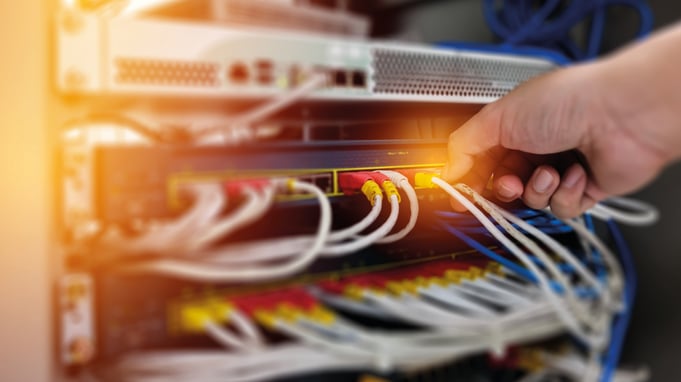
We live in a networked world – more and more services and products use networks for communication and content distribution. Do you need to be an IT engineer to be able to do network setups for your AV installation? Absolutely not.
If you rewind just a few years, sound, audio and lighting devices had their own, dedicated, communication connectivity. Not only did they have dedicated protocols, but also physical cables and connectors. What's more, inter-operability between these technologies was not a focus – neither for the users nor the developers. And IP (Internet Protocol) based networks were for the IT world, a completely different realm from the world of AV. But this is about to change.
You don't need to be an IT engineer to do AV networks, but you really need to have some key network skills. In this blog post, we take a look at the following topics:
- Introduction to networking
- What is TCP/IP?
- How does TCP differ from IP?
- What is an IP address anyway?
- How do I set or get an IP address?
- What is a subnet?
- What is a gateway?
- Network types and sizes
Introduction to networking
A network is a collection of devices such as computers, servers, printers or other devices which are connected, allowing them to communicate or share data. The best example of a network is Internet, where billions of people all over the world are connected and communicate through mobile phones, computers, tablets or any other device. Other networks you might be familiar with include your local network at home, or company network.
The common denominator for all of the devices connected to a network is that they need to speak the same language and that many of these networks share the same physical characteristics – they can be wired (a physical cable) or wireless (no strings attached ;)).
The language spoken by these devices, allowing them to communicate is called IP (Internet Protocol) or TCP/IP (Transmission Control Protocol/Internet Protocol). Let's dig into the gory details!
WHAT IS TCP/IP?
TCP stands for Transmission Control Protocol and is a connection-oriented and reliable protocol. IP (Internet Protocol) is a connection-less network layer protocol responsible for sending the packets to devices in the network.
TCP/IP is often referred to as the Internet protocol suite and is a set of communication protocols used for Internet and computer-based networks (as well as audio-visual networks). The TCP/IP suite provides end-to-end data communication specifying how data should be packed, addressed, sent and received. This functionality is organized in layers based on the OSI (Open Systems Interconnection) model.
Geek alert! OSI is a model that was developed to define and standardize the communication functions of a telecom or computing system without regard to its underlying internal structure and technology. Its main goal is to guarantee interoperability between communication systems through standardized protocols. The original version of the model defined seven layers:
- Physical
- Data Link Layer (Ethernet is here and so is wireless 802.11)
- Network Layer (IP is here)
- Transport Layer (TCP is here)
- Session Layer
- Presentation Layer
- Application Layer
I won't delve deeper into the OSI model here, but we might do so in a later blog. If you are hungry for more details on the OSI model, the Wiki page is a well of geeky details.
How does tcp differ from ip?
Not to put too fine a point on it, TCP is a reliable protocol while IP is not. IP protocol defines the addresses needed to send data (organized in packets) from source to destination. An IP address is used to providing a unique address for devices connected to a network (or Internet). The IP protocol operates in what is called a connectionless state and suffers from various error conditions such as corrupt data, packet loss, duplication and out-of-order delivery.
Basically: The sender will always send its packets but does not really care or test if the receiver does in fact receive them.
The TCP (Transmission Control Protocol) is different and reliable. This is because it is connection-oriented and has a system to verify if the receiver has actually received the data or if some data went missing along the way. Read more about the TCP/IP here.
The physical network
While the protocol is the set of rules that defines how devices communicate, there is also a need for a more physical approach to communication. Both Ethernet and Wi-Fi use a physical level address, and this is called the MAC address. A MAC address is a unique identifier assigned to the network interface controller (NIC). The MAC address is formatted like this: d3:0b:95:9d:78:18.
On my MacBook Air, my network configuration for my Wi-Fi (what I am connected to now) looks like this:
Davids-MacBook-Air:~ davidaleksandersen$ networksetup -getinfo Wi-Fi
DHCP Configuration
IP address: 192.168.8.104
Subnet mask: 255.255.255.0
Router: 192.168.8.1
Wi-Fi ID: d4:61:9d:36:c5:9c
Which leads us on to the details of network addressing…
What is an IP address?
Every device connected to a network or the Internet needs an IP address to be able to communicate with other devices. There are two versions of IP: IPv4 and IPv6. In this article we will only cover IPv4, but it is worth understanding the difference.
IPv4 is the fourth version of the Internet Protocol and has been used since Internet was not the Internet, but ARPANET, back in 1983. Although it has a successor in IPv6, it is IPv4 that handles most communication between devices and networks today.
IPv4 uses 32-bit addresses which limits the number of available addresses to 4 294 967 296 (232) addresses. Some of these are not available for use as they are allocated to private networks and multicast addresses.
There are too few IPv4 addresses and the process of migrating to IPv6 is going on as you read. The IPv6 address uses 128-bit addresses (32 in IPv4) which gives an insanely high number compared to IPv4's mere 4 billion. The number of IPv6 addresses is 340 282 366 920 938 463 463 374 607 431 768 211 456 (2128) or better (?) known as 340 undecillion addresses.
An IP address looks like my example above: 192.168.8.104. This is the unique IP address my MacBook uses when it communicates with other devices. IP addresses beginning with 192 are typically in use at office or home networks where you are connected to the network through a router/firewall. We will cover things like routers and firewalls in a later blog post.
How do I set or get AN IP ADDRESS?
While the MAC address belongs to and is physically set on the network interface control (NIC), the IP address is not fixed to the NIC.
To assign an IP address to the network interface, you can either set a static (fixed) IP or have the NIC receive one from a server on the network called a DHCP server (Dynamic Host Configuration Protocol). The Dynamic Host Configuration Protocol is a service running on the network, either as a dedicated DHCP server or in a router/firewall.
What is a subnet mask?
A subnet is typically used to split large networks into smaller, more logical network segments. According to Wiki, the practice of dividing a network into two or more networks is called subnetting. Subnets can be quite confusing, but they add several benefits if you understand them. Here are some of the benefits:
- IP address allocation.
- Network performance. If you have many devices on a network, it might yield improved network performance if you split the network into smaller parts.
- Management and security. By creating multiple networks, you can more easily confine traffic or avoid having the entire network compromised if you have a breach or a virus outbreak.
IP address: 192.168.8.104
Subnet mask: 255.255.255.0
With the above settings, the last of the four octets of the IP is available in full (000 to 255). If the last subnet is set to 255.255.0.0, you would have 256*256 addresses available (65 536). Note that the 192.168.8.255 address should not be assigned to any regular device on the net as it is the subnet´s broadcast address. And typically, the 192.168.8.1 address is used for the router/gateway.
If you set the subnet to 255.255.255.192, you would reduce the number of available IP-addresses on the subnet to 256-192 = 64.
If this still is confusing – which I understand it can be – there are several good resources on the topic, such as Subnetting for dummies by Spiceworks.
What is a gateway, and do I always need it?
On my MacBook, the term Gateway is not used but “Router”, which actually makes more sense, in most cases. The gateway address (default gateway or “router”) is a router interface connected to the local network that sends packets out of the local network. The gateway has both a physical and a logical address.
When you connect your device to a network, you won't normally have a public IP address – between you and the Internet you will find a router/firewall (the gateway). If you want to communicate with the outside world, your IP settings need to have the gateway value.
The gateway is always on the same network as the rest of the devices and the gateway address must have the same subnet mask. The gateway is typically assigned the highest or lowest network address (192.168.0.1 or 192.168.0.255). While this is not a requirement, most network administrators use a consistent addressing scheme to facilitate network planning.
The art of planning and structuring a LAN will be covered in a later blog post!
Network types and sizes
Networks are found in a wide range of sizes, from the smallest personal network with a couple of units connected, to large global company networks with tens of thousands of users and devices. The following terms are frequently used: PAN, LAN, MAN and WAN.
PAN – PERSONAL AREA NETWORK
This is the smallest type of network and is typically confined to a room, or a very small area. Examples: Connections using Bluetooth between a mobile phone and a portable speaker.
LAN – Local Area network
A local area network is as the name indicates, a network with a local reach. An office network or a home network is typically Local Area Networks. Office networks are usually based on a combination of cabled and wireless connectivity, while home networks are most often wireless.
MAN – Metropolitan Area network
A typical Metropolitan Area Network is in a city (a company can have multiple buildings in the same city) or a campus network with multiple buildings. The different buildings can be connected through wireless (not the regular Wi-Fi that we use at home or at the office, but microwave systems) or cable, such as rented, dedicated fiber optical infrastructure.
WAN – Wide area network
A WAN is virtually any network that has a wider reach than a local area network. Even a campus network that could be defined as a MAN can be defined as a WAN. If we extend a network so it covers multiple cities or even countries, we are safely into the WAN category.
The largest example of a WAN is the Internet, which consists of a number of smaller networks (LANs) around the world.
Further reading (or viewing)
I have written a follow-up article to this, where I cover planning and structuring a LAN, network components such as routers, switches and firewall, network security and the choice about wired or wireless networks.
In addition, Yamaha has a few video tutorials on networking which are both short and to the point:




